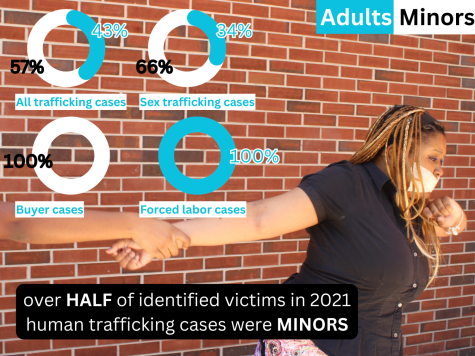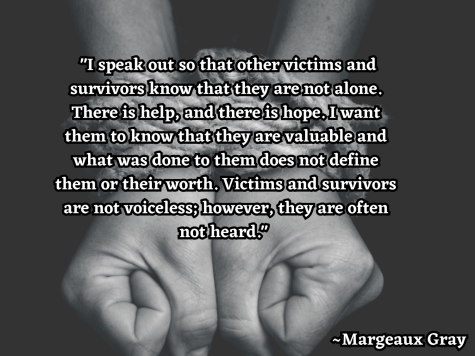Your donation will support the student journalists of North Cobb High School. Your contribution will allow us to purchase equipment and cover our annual website hosting costs.
The trauma behind child trafficking
April 26, 2023
Every day, millions of children and teenagers suffer as victims of human trafficking: the use of coercion, deception and force to secure free labor or a commercial sex act. While it stands as an underground crime that the bulk of the world does not see, society realizes that human trafficking contributes to the immense number of people who disappear, and that it happens at a higher frequency than a majority might think. However, the ability of sex trafficking rings to keep themselves out of sight from the public remains elusive to the comfort of thousands of civilians. Society also suffers from the bystander effect; they watch it happen as it occurs in front of their very eyes with minimal solutions in mind.

These ill-natured predators target young individuals who appear vulnerable or gullible, as the act must occur quickly and as quietly as possible. Traffickers typically prey on those who endure poverty, lack English proficiency and hold an unlawful immigration status, resulting in them not carrying stable housing and possessing limited educational opportunities. While trafficking can happen to anyone, children account for 27% of all human trafficking victims worldwide, and two out of every three child victims appear as girls. Furthermore, LGBTQ teenagers frequently deal with family members and friends kicking them out of the house, resulting in homelessness and vulnerability—the perfect combination to grab a predator’s attention.
“I think society should increase awareness in schools, not even just for females, but also males. Males also get human trafficked, especially the homosexual population of males. We have sex-ed classes in school, but we don’t talk about the aspects of human trafficking and how people end up in these situations. It’s just making sure teenagers have safe households, where they feel accepted and don’t feel like they have to go out and get these fake jobs and end up getting scammed by human traffickers,” magnet senior vice president Alison Bolanos said.
Although human trafficking victims can individually appear different, they all fall into the same trap. From a six-year-old boy talking to a stranger, to a runaway teenage girl who wants a job, they will all ultimately bear the same consequences. It only takes false promises of love or a fulfilling career to lure them into circumstances where predators force them to work inhumane hours for free.
“He was gorgeous and he had charm (human trafficker). I just wanted someone in my life to show me attention for a change, instead of being ignored. It was kind of exciting because it had the thrill of hiding away from the police when they were around. About seven months afterward, I had gotten raped. I tried to leave and it just turned out to be worse. I invested so much time and so much money into Juan that everything was tied to him. I didn’t have a house, I didn’t have a bank account, and I didn’t have my own car. I didn’t have anything. So if I left Juan I left everything,” human trafficking victim Nicole said.
However, human trafficking does not always happen to underprivileged children living in unstable households. With the use of social platforms such as Instagram, Snapchat and TikTok, typical middle-class kids find themselves caught in a trap that they can not escape. In numerous cases, adolescents and teens desire to meet with individuals that they find on social media because they do not see the harm in them. In reality, the person on social media holds ulterior motives, and the rich kid from down the street appears equally as gullible as a wayward teenage girl deserting her home. A 38-year-old predator abducted 13- year old Alicia Kozakiewicz from her Pittsburgh home in 2002, after luring her on the internet for months. Officials found Kozakiewicz tied up in chains in the basement of the man’s Virginia home, and she suffered from sexual assault. Kozakiewicz now aims to share her story through the Alicia Project, where she educates the world about the dangers of social media and she brings forth sexual exploitation awareness.

Similar to victims, predators can come in a variety of shapes and forms. Predators can entail family members, friends, acquaintances, strangers or foreigners; and they can choose to operate independently or as a team. In fact, strangers only carry out 24% of actual kidnappings, while nearly half are by family members. A multitude of people also usually believe that only men participate in the heinous crime when in reality the US has brought indictments against female traffickers as well. The public can find victims in legal and illegal labor sectors, making it difficult to identify them. This includes those that provide services to everyday people and businesses, such as nail salons, restaurants and hotels. In certain instances, predators of domestic servitude keep victims hidden in homes behind closed doors. However, it remains considerably strenuous for the world to even remotely recognize the crime when these victims work in broad daylight and engage with society. Civilians must remember that victims can physically appear helpless—tied up in a sketchy basement— or work as waitresses at one’s favorite restaurant in their community.
Due to the recency of COVID-19, human trafficking receives less attention from the media and the general public. A vast majority of lives may have experienced a delay due to the pandemic, but trafficking offenses did not come to a halt. Instead, traffickers have profited from the pandemic’s repercussions. According to the U.S. Department of State, a greater number of people stood at an elevated risk of acting as victims of trafficking as a result of the world experiencing higher levels of economic and social vulnerability. When the pandemic forced people to remain in the protection of their own homes, predators could easily coerce victims, as people craved socialization during the unprecedented period.
The human trafficker likely holds countless reasons for using children for free labor and sex objects. However, nine times out of 10, it all traces back to money. In several cases, a gang or an authoritative figure stands as the head of human trafficking circles, and the predator executing it profits heavily. In addition to working for higher powers, one could make a load of money by selling children overseas, where the minors no longer remain in their hands. Furthermore, traffickers use modes of transportation, such as air travel to transport their victims. Additionally, runaway teenagers that book particular flights appear helpless, thus making it easy to gain control of them. In fact, Atlanta’s Hartsfield-Jackson airport holds the 7th highest human trafficking rate in the US. With Atlanta ranking in the top ten busiest airports and serving as the 37th most populated city in the country, underground trafficking brings in over $300 million in Atlanta a year. When about to fly to their vacation destination, one must remember that the likelihood of someone on their flight enduring human trafficking remains high.
Society seems extremely aware of the issue, but it somehow continues to happen to children over 50,000 times a year. Citizens claim that they do what they can to prevent the issue— staying alert, not talking to strangers and proper self-defense. However, while these skills stand as crucial, these methods can ultimately prove ineffective and unproductive because citizens do not typically apply those rules to their day-to-day life. While society owes this to social media and just lacks overall education regarding human trafficking, it does not hinder predators from carrying out their mission. A first step to active precautions against child trafficking entails educating children at a young age about the criminal act. Parents frequently shelter their kids with pure intentions and claim that their young ones should not know the realities of the harsh world they live in. If they hear cases of people their age who have suffered from such a traumatic event, they will know the ‘why’ to everything— why they should not talk to strangers, and why they should not walk alone— as opposed to their higher power simply telling them to refrain from doing it.
“I think I was aware of human trafficking at a very young age simply because I was born in Mexico City, which is one of the most populated cities in the world, but it also tends to be pretty dangerous, especially with all of the corruption going on in Mexico City. I have actually dealt with family members who have been kidnapped and have been through their own human trafficking experiences. I feel like in school, it’s not an issue that’s spoken about a lot. Especially about how girls can be safe about it, I mainly just learned about it because of where I lived and my parents, along with the media. The more I heard about girls, in particular, speaking about their experiences, the more I learned that this is a very prevalent issue,” Bolanos said.
